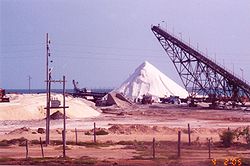- The White symbolizes the purity of the indigenous people of La Guajira who are known to be peaceful and noble.
- The White also symbolizes the natural riches of La Guajira. Here, the Salinas de Manaure, a salt mine in the north of La Guajira.
 | |
| Use | Civil and state flag |
|---|---|
| Adopted | September 29, 1966 |
| Design | Rectangular horizontal bicolour of equal proportions in green and white. |
The flag of La Guajira was officially adopted by the Departmental Assembly by means of Ordinance 028 of September 29, 1966. Previously, the flag had already been in use as the flag of the Intendancy of La Guajira, and subsequently it was modified last by Ordinance 052 of 1994. The Gubernatorial Standard is based on the Flag of the department but it is charged at the centre with the Coat of arms of the Department of La Guajira. [1] [2]

